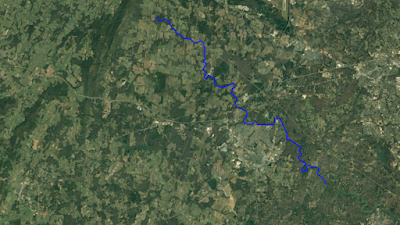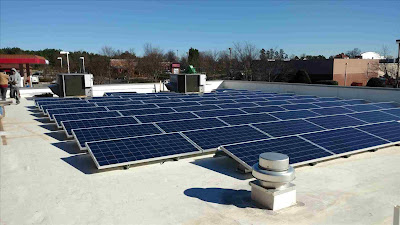Less development or smarter development?
LEEDing The Way to Sustainability
The Developing Development Problem
Northern Virginia (NOVA) is subgroup of counties in Virginia that includes Fairfax, Prince William, and Loudoun Counties, and are often considered part of the Washington District of Colombia's metropolitan surroundings. These three counties along with a handful of cities such as Manassas, Reston, Arlington, and Alexandria account for roughly a half of Virginia's 8 million people according to the 2010 census. The areas population has increased since 2010 and the need to house and accommodate the the rising population has resulted in increased development in all counties and cities. The area surrounding Bull Run has experienced large growth with current estimates indicating a 15.9% increase in county population and a 16.5% and a 9.5% increase in Manassas city park, and Manassas city respectively. The primary problem with the large and rapid population growth is the dramatic loss of green spaces and permeable surfaces resulting in increased storm-water runoff and pollution reducing in stream habitat and water quality. Negatively impacted impacted waterways see a loss of aquatic and terrestrial wildlife. Ultimately, rapid over development results in the loss of natural resources and results in the loss of ecstatic, ecological, and economical benefits they provide for humans.
Google Earth satellite Imagery of Bull Run 2016.
Developing Solutions
Conservation and preservation are common strategies used when considering human development. The United States has used both strategies frequently throughout history, for example the creation of a national parks system set aside land to be preserved and protected without human impacts while other public land like those managed by the Bura of Land Management or the Department of Forestry seek to use land substantially so that future generation can use the same land in the same way, Conserving it. For many reasons, including continued population growth both these strategies can prove ineffective, for example preservation and conservation areas in close proximity to development can and are negativity impacted by the figurative and literal spillover of from developed areas.
A less conventional, but rapidly growing philosophy sees development as the solution to the development problem. Development that seeks to conserve and persevere the natural resources on the land its developing my in theory provide a human need (i.e. home, industry, transportation) with little to no negative impacts. This type of development has become known as sustainable development. The organization and standardization of sustainable building is important to ensure standards are set and upheld. One such system is the LEED system.
What is LEED?
Leading in Energy and Environmental Design (LEED)
What Do Green Buildings Look Like
LEEDing the way: Wetland Studies and Solutions
Wetland Studies and Solutions, Inc founded in 1991 and a Wholly Owned Subsidary of The Davey Tree Expert Company as of April 2014 is "the leading natural and cultural resources consultant in the Mid-Atlantic. The company is comprised of scientists, regulatory specialists, engineers, surveyors, permit compliance specialists, archaeologists, ecosystem and restoration specialists, arborists, and geographic information specialists that provide expertise and experience for public and private sector builders to obtain the environmental approvals needed to create the built environment.
The Wetland's main office built in 2005 was Virginia's first Gold-certified building under the LEED rating system. The building sought to create a balance between commercial and biological uses as well as be a real world experiment of sustainable building practices.
Solar Power and Usage
The WSSI office supplements its power needs through the use of solar paneling. Solar panels coupled with motion and timed lights the office can reduce its electricity use. The WSSI solar system can contribute to the power grid meaning the building produces more energy then it uses.
Green Roof
Portions of the office utilize green roof or living roof in which a roof is vegetated in a light soil with a waterproof lining. Green roofs unlike traditional roofing can absorb and slow rainfall much like a forest or vegetated field. Slowing the intensity of rainfall can reduce the rate of runoff protecting streams from structural damage.
Rain Gardens
Rain gardens, also known as bio-retention basins, are shallow, gently-depressed areas which hydrologically resemble sites of intermittent ponding on the forest floor. They are designed to pond water on the surface during storm events and allow the water to infiltrate once the storm passes. The infiltration process removes pollutants from the water and makes it available for uptake by plants. WSSI's 1,536 square foot rain garden accepts surface flow from approximately 9,500 square feet of impervious parking and driving surfaces behind the WSSI building.
The rain garden is separated from impervious areas by an 11,700 square foot buffer of sod and planting beds, which provides initial runoff filtering and frames the rain garden in more conventional landscaping. The rain garden also accepts overflow from the outdoor cistern whenever its capacity is exceeded. Overflow from the cistern is released just beneath the mulch layer so that it receives the full benefit of filtration through the soil media.
Cistern and Detention systems
Cisterns are water storage units that supply water for traditionally non-palatable uses such as crop watering or toilet flushing. The WSSI office uses two cisterns as part of a water detention system. Precipitation that falls onto the office solar roof does not flow using a gutter system, but instead flows to the indoor cistern. The indoor cistern is used to flush all toilets throughout the office. Once full, the indoor cistern sends overflow to an outdoor cistern before emptying into a public storm-water system. The WSSI cistern system helps to absorb precipitation reducing the runoff from the building. The cisterns can be actively managed allowing the office to discharge storm-water after storm events and at rates that do not damage streams.
 Native Landscaping
Native Landscaping
Natural landscaping, also called native gardening, is the use of native plants, including trees, shrubs, ground cover, and grasses which are indigenous to the geographic area of the garden. The WSSI office uses native vegetation throughout the office grounds including the green roof, rain garden, and bioswale. Allowing native vegetation to grow naturally, can increase precipitation interception as well as provide habitat Checkout the office seed and planting list.
Bioswales

Permeable Parking
The office utilizes four types of previous parking types all of which allow the infiltration of precipitation and runoff into the soil below the WSSI office parking lot.
 Previous Pavers : The pavers resemble standard paving blocks, except their corners have been cut to give the surface approximately 10% void space. The voids are filled with angular gravel, which is extremely porous and allows stormwater to soak down between the pavers into an 8” gravel reservoir below. A diagram of a typical design can be viewed below. The previous pavers reduce sheet flow and storm water intestines. The void space must be maintained and clear of vegetation and dirt. If not maintained void space can clog and the surface can become impervious.
Previous Pavers : The pavers resemble standard paving blocks, except their corners have been cut to give the surface approximately 10% void space. The voids are filled with angular gravel, which is extremely porous and allows stormwater to soak down between the pavers into an 8” gravel reservoir below. A diagram of a typical design can be viewed below. The previous pavers reduce sheet flow and storm water intestines. The void space must be maintained and clear of vegetation and dirt. If not maintained void space can clog and the surface can become impervious.  GavelPave: Specificaly the GravelPave2 is a grid of plastic rings fused to a filter-fabric backing. The product is laid over a gravel base, and the rings are filled with small, angular, gap-graded gravel. The gravel is held in place by the rings and fabric, and storm water can soak through the filter fabric and into the gravel base below. Perforated under drains within the gravel base then allow the water to drain to the vegetated floodplain. GravelPave helps reduce storm water runoff rates and sheet flow. The Gravel Pavers are the weakest form of previous parking. gravel must be regularly maintained, plastic rings can brake, gravel can be washed out during intense rainfall, and gravel can be tracked off site.
GavelPave: Specificaly the GravelPave2 is a grid of plastic rings fused to a filter-fabric backing. The product is laid over a gravel base, and the rings are filled with small, angular, gap-graded gravel. The gravel is held in place by the rings and fabric, and storm water can soak through the filter fabric and into the gravel base below. Perforated under drains within the gravel base then allow the water to drain to the vegetated floodplain. GravelPave helps reduce storm water runoff rates and sheet flow. The Gravel Pavers are the weakest form of previous parking. gravel must be regularly maintained, plastic rings can brake, gravel can be washed out during intense rainfall, and gravel can be tracked off site.
Previous Concrete: Previous concrete is made in approximately the same manner as standard concrete, except the fine material is removed and an admixture is added to help it cure properly. Removing the fine material gives the concrete very high porosity and permeability, allowing water that would run off of standard concrete to soak straight down through. Water that seeps through the previous concrete enters into the gravel bed detention area. Previous concrete is not as strong as traditional concrete, but is likely the toughest and most durable form of previous parking. The surface must be maintained being vacuumed and cleaned of sediment to ensure the surface maintains its porosity.
Other
An important part of commercial office is the employee. The WSSI off offers a number of employee benefits w










Comments
Post a Comment